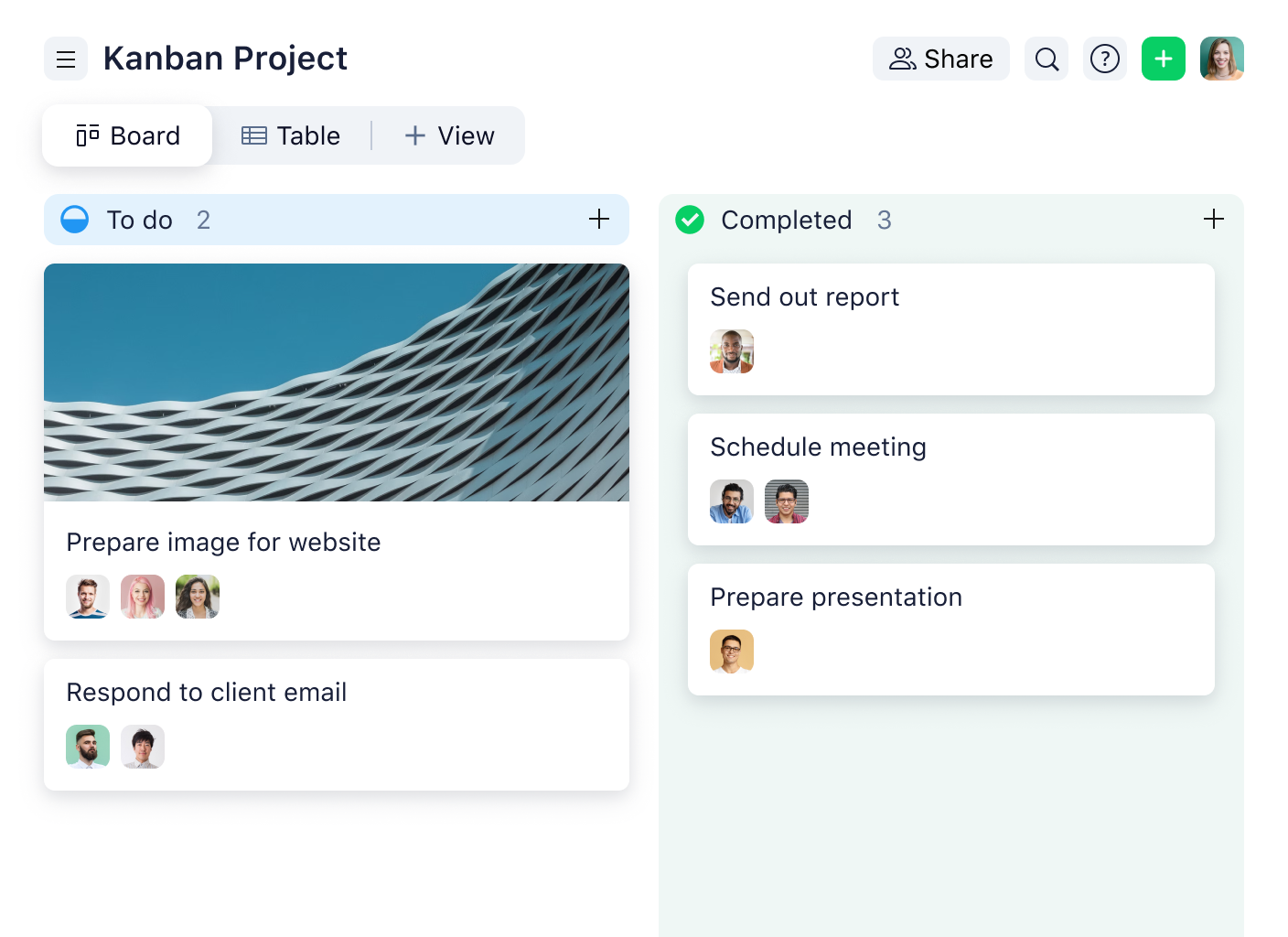Kanban is a project management methodology that helps teams work more efficiently by managing tasks visually. Kanban principles and practices today are different from those developed in the 1940s when the methodology was originally developed.
Over the decades, advances in technology and innovation have transformed industries, meaning that Kanban’s just-in-time and pull systems have expanded beyond manufacturing. The digital era has created new markets altogether, including ones powered by software running on computers and online. In fact, according to Wrike’s 2024 Impactful Work Report, 85% of businesses that have invested in new software have experienced increased efficiency.
In this guide, I’ll walk you through:
- The four important Kanban principles and why they matter
- How Kanban can boost your Agile team’s efficiency
- Practical ways to apply Kanban best practices
- How you can eliminate silos with Wrike’s Kanban boards
Let’s get right into it.
History of Kanban
Taiichi Ohno, who is considered the father of Kanban, focused much of his work on limiting waste, which was a major issue in car manufacturing plants at the time. Today, his “Seven Wastes” model remains relevant in sectors like manufacturing. That said, his ideas and principles have also influenced the service industry as well as disciplines such as software development, sales, marketing, and customer care.
I have seen many organizations invest more in people, giving them the tools and environments for them to be more productive. Because of this, Kanban has been adapted to fit a broader context based on:
- Industries
- Technologies
- Types of organizations
- Working practices
One of the main reference points for Kanban is David J. Anderson, a management consultant and pioneer of the Kanban methodology and a number of related frameworks. His book, “Kanban: Successful Evolutionary Change for Your Technology Business,” is regarded as one of the best resources on Kanban. In the book, Anderson covers five core properties that characterize successful Kanban implementations — a list that has since grown into a more comprehensive set of four Kanban principles and six Kanban practices.
The 4 Kanban principles
If you’re familiar with the Agile manifesto principles, these will look familiar to you:
- Start with what you do now.
- Agree to pursue incremental, evolutionary change.
- Respect the current process, roles, responsibilities, and titles.
- Encourage acts of leadership at all levels in your organization.
The first one is particularly significant, since it is a key requirement now as it was sixty years ago. Kanban needs to sit on top of existing processes and not replace them. It would have been too disruptive and costly to change the modus operandi altogether. Instead, Kanban was designed to streamline existing systems, making it a valuable tool for Agile teams looking to improve productivity without overhauling their workflows.
Let’s look at each of the four core principles of Kanban in more detail:
1. Start with what you do now
As I mentioned earlier, Kanban acts like a “power-up” that recognizes value where it exists and addresses issues that hinder processes and outcomes. Every aspect is considered: workflows, roles, responsibilities, titles, communications, and any other component of the process.
This principle is a useful selling point for Kanban too. It becomes easier to justify implementation costs when you can clearly present the benefits: minimal disruption, maximizing efficiencies, and cost savings.
Change management professionals will highlight these as part of a discovery phase at the start of a project, quantifying ROI over time as well as the additional transparency Kanban delivers. It becomes easier working with existing project managers too, as they won’t feel threatened by changes coming their way.
2. Agree to pursue incremental, evolutionary change
This principle relates closely to the first one and is also a key one in Agile and Scrum. Kanban’s model is less time-based than the latter, which organizes work in sprints. The notion of continuous development is shared by both, as is delivering change in small, manageable increments.
Kanban recognizes that big changes are hard to implement and are likely to meet resistance on multiple fronts. Senior management is typically concerned about spiraling costs, while project teams feel that changes to their working practices may slow them down and affect quality.
3. Respect the current process, roles, responsibilities, and titles
This is another principle that reinforces the idea that Kanban is not a disrupting force taking over established operational models. In this respect, Kanban is more of a compromise, gently improving legacy processes without changing the underlying framework.
The objective is to gain support for Kanban in an environment where people may have a vested interest in established practices. This is particularly true for larger organizations where change is slower and harder to achieve.
4. Encourage acts of leadership at all levels in your organization
Kanban recognizes the power of collaboration but also allows anyone to take ownership of an issue and address it. Armed with strong justification and data to back up an argument, anyone should be able to take action.
By promoting a culture of safety, as David J. Anderson refers to it, Kanban empowers team members to lead, take risks, and grow professionally.
Overview of the 6 Kanban practices
While there are some overlaps with other Agile project management frameworks, Kanban is based on pull systems, allowing you to start work where there is demand for a deliverable. Contrast this to a time-based approach like Scrum, where sprints and events follow strict schedules.
The six Kanban best practices are:
1. Visualize (the work, the workflow, and the business risks)
Most people involved in project management are familiar with Kanban boards, whether used in Scrum meetings or online task management. Think of these as dashboards for project work, where the intention is to give visibility to as much information as possible in an easily understandable format.
In its simplest form, a Kanban board features three stages:
- To do
- In progress
- Completed
You can also add more stages to best serve a particular process, e.g., adding a “Review” stage between “In progress” and “Done.” Following Kanban board best practices ensures these stages stay clear and actionable.

The sequence across the stages is referred to as the workflow. It starts with discovery activities (e.g., a request being made) and ends with delivery — the feature that has been completed and delivered back to the customer.
In the Kanban system, there are three items that need to be visualized. These are the work, workflow, and business risks.
Work: Each card represents individual tasks. You can quickly understand what stage they are in by looking at the column. A quick glance at the board helps you understand how the project as a whole is progressing.
Workflow: These are represented by different stages, from left to right on a Kanban board.

Business risks: You may need to look at details for each card to determine business risks, but there often are visual cues. For example, if more cards than expected are listed in the “Doing” or “In progress” stage, there may be a bottleneck slowing down work.
Whether using an online board or a paper-based system, color codes, tags, and labeling are useful to highlight key information.
2. Limit work in progress (WIP)
Kanban University puts it this way: ’’When resources are fully utilized there is no slack in the system and the result is very poor flow, just as in rush hour on the freeway.’’
Limiting WIP ensures that at any point in time, there is never too much or too little work to do. You want to have just the right amount of cards on a Kanban board that can be handled by the resources available.
This is achieved by implementing a pull system where new work is only “pulled” in when there is enough capacity to handle it. For this to work, limits to WIP need to be set and adjusted (e.g., to have a team of 20 engineers and operators build 10 cars a week).
And the numbers speak for themselves. At Arvig, adopting Wrike for enterprise-wide project management saved the HR team 900+ hours a year on administrative work and helped it greatly reduce project durations.
Shaun Carlson, Director of R&D and Continuous Innovation at Arvig, said:
“With Wrike, projects that had taken nine months to complete now take 16 weeks. Today, we can manage 250% more projects, which means we can be more responsive, increasing customer satisfaction.”
3. Manage flow
Flow refers to the movement of work items across stages of a process, as represented by cards on a Kanban board.
The responsibility lies with the project manager (or whoever is given ownership of the process). They need to keep the workflow moving fast while keeping an eye on blocks, bottlenecks, risks, and burnouts.
According to Wrike’s 2023 Efficiency Report, 57% of business leaders have heard their teams express concerns about being overworked. What’s more, 47% of leaders feel the pressure to enhance efficiency while also watching out for burnout.
Tracking speed and smoothness of flow allows leadership to determine how efficient a process is and how that affects the bottom line. As a metric, it isn’t dissimilar to velocity in Scrum, which is one of the more important ones.
4. Make policies explicit
By having an explicit understanding of issues, operations, and rules, discussions become more rational and objective. These need to be documented and shared across the Kanban team. The intention is to prevent emotion and subjective views from seeping into the decision-making process.
5. Implement feedback loops
Feedback and continuous improvements are critical for Kanban as they are for other Agile frameworks. In Kanban, feedback is gathered at different stages of a project: during meetings or at delivery, operational, and risk reviews.
The frequency and format of feedback depend on what has been already established by the project office. Any gaps are filled as Kanban identifies them.
6. Improve collaboratively, evolve experimentally
In the Kanban project management approach, collaboration and experimentation go hand in hand as long as there is clarity and consensus on how to approach work and issues.
In his book, David J. Anderson talks about teams having a shared comprehension of problems and suggests the adoption of a model to predict the effect of change. These include:
- The Theory of Constraints
- The Theory of Profound Knowledge
- The Lean Economic Model
By using a proven model, it becomes easier to measure outcomes, including the changes leading to them. This helps retain clarity and mitigate risks.
Integrate Kanban principles with Wrike
Ready to manage projects using Kanban principles and values? Wrike is the perfect tool to keep your project organized. From customizable Kanban boards to prebuilt project templates, Wrike gives you the flexibility to tailor workflows to your team’s needs while helping you focus on continuous improvement.
In my experience, Wrike’s Kanban boards offer a visual approach that makes it easy to manage tasks, prioritize work, and track progress at every stage.

But don’t just take my word for it. Companies like MTD have seen firsthand how Wrike transforms the way they manage projects. Ryan Cmich, Chief Products Engineer at MTD, shared:
“When the software team is together looking at their work in a Kanban style using Wrike’s custom dashboards, they can see where things are sitting in that process.”
Bring Kanban principles to life in your projects today — choose Wrike.


